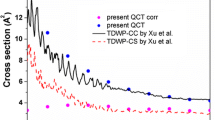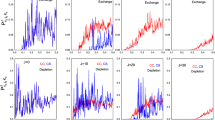Abstract
In this article, the dynamics of the nonreactive and abstraction channels for H + MgD and D + MgH reactions at low collision energies are studied with the quasi-classical trajectory method. Isotopic effects on both differential cross sections and the state distributions are obvious. By distinguishing the roaming processes into roaming during the reaction and roaming before product, differences in state distributions of the products and the isotopic effects are found in these two types of roaming.
Graphic Abstract








Similar content being viewed by others
Data Availability Statement
This manuscript has no associated data or the data will not be deposited. [Authors’ comment: The datasets generated during and/or analyzed during the current study are available from the corresponding author on reasonable request.]
References
P.L. Houston, S.H. Kable, Photodissociation of acetaldehyde as a second example of the roaming mechanism. Proc. Natl. Acad. Sci. 103(44), 16079–16082 (2006). https://doi.org/10.1073/pnas.0604441103
A.G. Suits, Roaming atoms and radicals: a new mechanism in molecular dissociation. Acc. Chem. Res. 41(7), 873–881 (2008). https://doi.org/10.1021/ar8000734
M.L. Hause, N. Herath, R. Zhu, M.C. Lin, A.G. Suits, Roaming-mediated isomerization in the photodissociation of nitrobenzene. Nat. Chem. 3(12), 932–937 (2011). https://doi.org/10.1038/NCHEM.1194
E. Kamarchik, L. Koziol, H. Reisler, J.M. Bowman, A.I. Krylov, Roaming pathway leading to unexpected water + vinyl products in \(\text{ C}_{2}\text{ H}_{4}\text{ OH }\) dissociation. J. Phys. Chem. Lett. 1(20), 3058–3065 (2010). https://doi.org/10.1021/jz1011884
V. Goncharov, N. Herath, A.G. Suits, Roaming dynamics in acetone dissociation. J. Phys. Chem. A 112(39), 9423–9428 (2008). https://doi.org/10.1021/jp802534r
B.R. Heazlewood, M.J. Jordan, S.H. Kable, T.M. Selby, D.L. Osborn, B.C. Shepler, B.J. Braams, J.M. Bowman, Roaming is the dominant mechanism for molecular products in acetaldehyde photodissociation. Proc. Natl. Acad. Sci. 105(35), 12719–12724 (2008). https://doi.org/10.1073/pnas.0802769105
D. Townsend, S.A. Lahankar, S.K. Lee, S.D. Chambreau, A.G. Suits, X. Zhang, J. Rheinecker, L.B. Harding, J.M. Bowman, The roaming atom: straying from the reaction path in formaldehyde decomposition. Science 306(5699), 1158–1161 (2004). https://doi.org/10.1126/science.1104386
J.M. Bowman, Roaming. Mol. Phys. 112(19), 2516–2528 (2014). https://doi.org/10.1080/00268976.2014.897395
X. Wang, Y. Zheng, H. Yang, Analysis of the roaming trajectories from the dynamic and kinematic perspectives: a representative study of triatomic systems. Chem. Phys. Lett. 776, 138599 (2021). https://doi.org/10.1016/j.cplett.2021.138599
A. Li, J. Li, H. Guo, Quantum manifestation of roaming in \({\text{ H } + \text{ MgH }} \rightarrow {\text{ Mg } + \text{ H}_{2}}\): the birth of roaming resonances. J. Phys. Chem. A 117(24), 5052–5060 (2013). https://doi.org/10.1021/jp4049988
F.A.L. Mauguière, P. Collins, S. Stamatiadis, A. Li, G.S. Ezra, S.C. Farantos, Z.C. Kramer, B.K. Carpenter, S. Wiggins, H. Guo, Towards understanding the roaming mechanism in \({\text{ H } + \text{ MgH }} \rightarrow {\text{ Mg } + \text{ HH }}\) reaction. J. Phys. Chem. A 120(27), 5145–5154 (2016). https://doi.org/10.1021/acs.jpca.6b00682
Z. Huang, R. Li, M. Ge, Y. Zheng, X. Meng, H. Yang, Study of the dynamics and isotopic effects in the \(\text{ D } + \text{ MgD }\) reaction using the quasi-classical trajectory method. Chem. Phys. Lett. 685, 229–238 (2017). https://doi.org/10.1016/j.cplett.2017.07.076
C.D. Foley, C. Xie, H. Guo, A.G. Suits, Orbiting resonances in formaldehyde reveal coupling of roaming, radical, and molecular channels. Science 374, 1122–1127 (2021). https://doi.org/10.1126/science.abk0634
Y. Xie, H. Zhao, Y. Wang, Y. Huang, T. Wang, X. Xu, C. Xiao, Z. Sun, D.H. Zhang, X. Yang, Quantum interference in \({\text{ H } + \text{ HD }} \rightarrow {\text{ H}_{2} + \text{ D }}\) between direct abstract and roaming insertion pathways. Science 368, 767–771 (2020). https://doi.org/10.1126/science.abb1564
A. Nandi, P. Zhang, J. Chen, H. Guo, J.M. Bowman, Quasiclassical simulations based on cluster models reveal vibration-facilitated roaming in the isomerization of \(\text{ CO }\) adsorbed on \(\text{ NaCl }\). Nat. Chem. 13, 249–254 (2021). https://doi.org/10.1038/s41557-020-00612-y
T. Takayanagi, T. Tanaka, Roaming dynamics in the \({\text{ MgH } + \text{ H }} \rightarrow {\text{ Mg } + \text{ H}_{2}}\) reaction: quantum dynamics calculations. Chem. Phys. Lett. 504(4), 130–135 (2011). https://doi.org/10.1016/j.cplett.2011.02.002
S. Liu, X. Xu, D.H. Zhang, Communication: State-to-state quantum dynamics study of the \({\text{ OH } + \text{ CO }} \rightarrow {\text{ H } + \text{ CO}_2}\) reaction in full dimensions (\(j = 0\)). J. Chem. Phys. 135(14), 141108 (2011). https://doi.org/10.1063/1.3653787
H. Yang, K.L. Han, G.C. Schatz, S.H. Lee, K. Liu, S.C. Smith, M. Hankel, Integral and differential cross sections for the \({\text{ S }(^{1}\text{ D}) + \text{ HD }}\) reaction employing the ground adiabatic electronic state. Phys. Chem. Chem. Phys. 11, 11587–11595 (2009). https://doi.org/10.1039/B917972K
B.C. Shepler, B.J. Braams, J.M. Bowman, “Roaming’’ dynamics in \({\text{ CH}_{3}\text{ CHO }}\) photodissociation revealed on a global potential energy surface. J. Chem. Phys. A 112(39), 9344–9351 (2008). https://doi.org/10.1021/jp802331t
W.A.D. Pires, J.D. Garrido, M.A.C. Nascimento, M.Y. Ballester, A quasi-classical trajectory study of the \({\text{ OH } + \text{ SO }}\) reaction: the role of ro-vibrational energy. Phys. Chem. Chem. Phys. 16, 12793–12801 (2014). https://doi.org/10.1039/C4CP01363H
J.L. Rheinecker, X. Zhang, J.M. Bowman, Quasiclassical trajectory studies of the dynamics of \({\text{ H}_{2}\text{ CO }}\) on a global ab initio-based potential energy surface. Mol. Phys. 103(6–8), 1067–1074 (2005). https://doi.org/10.1080/00268970412331333483
Y. Fu, Y. Bai, Y. Han, B. Fu, D.H. Zhang, Double-roaming dynamics in the \({\text{ H } + \text{ C}_{2}\text{ H}_{2}} \rightarrow {\text{ H}_{2} + \text{ C}_{2}\text{ H }}\) reaction: acetylene-facilitated roaming and vinylidene-facilitated roaming. J. Phys. Chem. Lett. 12, 4211–4217 (2021). https://doi.org/10.1021/acs.jpclett.1c01045
Y. Fu, X. Lu, Y. Han, B. Fu, D.H. Zhang, J.M. Bowman, Collision-induced and complex-mediated roaming dynamics in the \({\text{ H } + \text{ C}_{2}\text{ H}_{4}} \rightarrow {\text{ H}_{2} + \text{ C}_{2}\text{ H}_{3}}\) reaction. Chem. Sci. 11, 2148–2154 (2020). https://doi.org/10.1039/C9SC05951B
H. Li, D. Xie, H. Guo, An ab initio potential energy surface and vibrational states of \({\text{ MgH}_{2}}(1^{1}{\text{ A }}^{\prime })\). J. Chem. Phys. 121(9), 4156–4163 (2004). https://doi.org/10.1063/1.1777215
H. Li, R.J. Le Roy, Spectroscopic properties of \({\text{ MgH}_{2}}\), \({\text{ MgD}_{2}}\), and \({\text{ MgHD }}\) calculated from a new ab initio potential energy surface. J. Phys. Chem. A 111(28), 6248–6255 (2007). https://doi.org/10.1021/jp072510m
X. Hu, W.L. Hase, T. Pirraglia, Vectorization of the general Monte Carlo classical trajectory program VENUS. J. Compt. Chem. 12(8), 1014–1024 (1991). https://doi.org/10.1002/jcc.540120814
R. Li, K. Han, F. Li, R. Lu, G. He, N. Lou, Rotational alignment of product molecules from the reactions \({\text{ Sr } + \text{ CH}_{3}\text{ Br }}\), \({\text{ C}_{2}\text{ H}_{5}\text{ Br }}\), \({\text{ n }-\text{ C}_{3}\text{ H}_{7}\text{ Br }}\), \({\text{ i }-\text{ C}_{3}\text{ H}_{7}\text{ Br }}\) by means of PLIF. Chem. Phys. Lett. 220(3), 281–285 (1994). https://doi.org/10.1016/0009-2614(94)00174-X
F.J. Aoiz, L. Bañares, V.J. Herrero, Recent results from quasiclassical trajectory computations of elementary chemical reactions. J. Chem. Soc. Faraday Trans. 94, 2483–2500 (1998). https://doi.org/10.1039/A803469I
K. Han, G. He, N. Lou, Effect of location of energy barrier on the product alignment of reaction \({\text{ A } + \text{ BC }}\). J. Chem. Phys. 105(19), 8699–8704 (1996). https://doi.org/10.1063/1.472651
M. Ben-Num, R.D. Levine, Conservation of zero-point energy in classical trajectory computations by a simple semiclassical correspondence. J. Chem. Phys. 101, 8768–8783 (1994). https://doi.org/10.1063/1.468071
W.H. Miller, W.L. Hase, C.L. Darling, A simple model for correcting the zero point energy problem in classical trajectory simulations of polyatomic molecules. J. Chem. Phys. 91, 2863–2868 (1989). https://doi.org/10.1063/1.456956
Y. Sun, S.S. Dong, K.A. Parker, J.L. Bao, L. Zhang, D.G. Truhlar, Extended Hamiltonian molecular dynamics: semiclassical trajectories with improved maintenance of zero point energy. Phys. Chem. Chem. Phys. 20, 30209–30218 (2018). https://doi.org/10.1039/c8cp04914a
J.M. Bowman, B. Gazdy, Q. Sun, A method to constrain vibrational energy in quasiclassical trajectory calculations. J. Chem. Phys. 91, 2859–2862 (1989). https://doi.org/10.1063/1.456955
A.J.C. Varandas, Excitation function for \({\text{ H } + \text{ O}_{2}}\) reaction: a study of zero-point energy effects and rotational distributions in trajectory calculations. J. Chem. Phys. 99, 1076–1085 (1993). https://doi.org/10.1063/1.465407
S. Tada, Treatment of quantum zero-point energy constraint in simulations of molecular dynamics. Eng. Comput. 28, 508–523 (2011). https://doi.org/10.1108/02644401111131911
C.C. Martens, Surface hopping by consensus. J. Phys. Chem. Lett. 7, 2610–2615 (2016). https://doi.org/10.1021/acs.jpclett.6b01186
B.C. Shepler, Y. Han, J.M. Bowman, Are roaming and conventional saddle points for \({\text{ H}_{2}\text{ CO }}\) and \({\text{ CH}_{3}\text{ CHO }}\) dissociation to molecular products isolated from each other? J. Phys. Chem. Lett. 2(7), 834–838 (2011). https://doi.org/10.1021/jz2002138
L.B. Harding, S.J. Klippenstein, A.W. Jasper, Separability of tight and roaming pathways to molecular decomposition. J. Phys. Chem. A 116(26), 6967–6982 (2012). https://doi.org/10.1021/jp303581k
J.M. Bowman, X. Zhang, New insights on reaction dynamics from formaldehyde photodissociation. Phys. Chem. Chem. Phys. 8, 321–332 (2006). https://doi.org/10.1039/B512847C
W.H. Green, C.B. Moore, W.F. Polik, Transition states and rate constants for unimolecular reactions. Ann. Rev. Phys. Chem. 43(1), 591–626 (1992). https://doi.org/10.1146/annurev.pc.43.100192.003111
Acknowledgements
H. Yang thanks Prof. Joel M. Bowman for suggestions when visiting at Emory University. This work was supported by the National Natural Science Foundation of China (Grants No. 12174221 and No. 11674196). H. Yang is grateful for the support of the Taishan Scholars Project of Shandong Province (Grant No. ts201712011).
Author information
Authors and Affiliations
Contributions
All authors contributed to the study conception and design. XW performed the data curation and wrote the original draft. HY carried out the analysis, and reviewed and edited the draft. YZ provided computing resources and part of funding.
Corresponding author
Rights and permissions
Springer Nature or its licensor holds exclusive rights to this article under a publishing agreement with the author(s) or other rightsholder(s); author self-archiving of the accepted manuscript version of this article is solely governed by the terms of such publishing agreement and applicable law.
About this article
Cite this article
Wang, X., Zheng, Y. & Yang, H. Roaming in the isotopic reactions of H + MgD and D + MgH. Eur. Phys. J. D 76, 184 (2022). https://doi.org/10.1140/epjd/s10053-022-00518-z
Received:
Accepted:
Published:
DOI: https://doi.org/10.1140/epjd/s10053-022-00518-z




